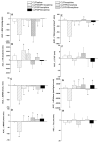Role of Central Inflammatory and Oxidative Pathways in the Morphine Exacerbation of Cardiovascular Effects of Sepsis in Rats
- PMID: 40573276
- PMCID: PMC12195926
- DOI: 10.3390/ph18060882
Role of Central Inflammatory and Oxidative Pathways in the Morphine Exacerbation of Cardiovascular Effects of Sepsis in Rats
Abstract
Background/Objectives: Sepsis remains one of the most serious and possibly fatal complications encountered in intensive care units. Considering the frequent use of narcotic analgesics in this setting, we investigated whether the cardiovascular and peripheral and central inflammatory features of sepsis could be modified by morphine. Methods: Rats were instrumented with femoral and intracisternal (i.c.) indwelling catheters and sepsis was induced by cecal ligation and puncture (CLP). Results: The i.v. administration of morphine (3 and 10 mg/kg) significantly and dose-dependently aggravated septic manifestations of hypotension and impaired cardiac autonomic activity, as reflected by the reductions in indices of heart rate variability (HRV). Cardiac contractility (dP/dtmax) was also reduced by morphine in septic rats. The morphine effects were mostly eliminated following (i) blockade of μ-opioid receptors by i.v. naloxone and (ii) inhibition of central PI3K, MAPK-ERK, MAPK-JNK, NADPH oxidase (NADPHox), or Rho-kinase (ROCK) by i.c. wortmannin, PD98059, SP600125, diphenyleneiodonium, and fasudil, respectively. Further, these pharmacologic interventions significantly reduced the heightened protein expression of toll-like receptor 4 (TLR4) and monocyte chemoattractant protein-1 (MCP1) in brainstem rostral ventrolateral medullary (RVLM), but not cardiac, tissues of CLP/morphine-treated rats. Conclusions: Morphine worsens cardiovascular and autonomic disturbances caused by sepsis through a mechanism mediated via μ-opioid receptors and upregulated central inflammatory, chemotactic, and oxidative signals. Clinical studies are warranted to re-affirm the adverse cardiovascular interaction between opioids and the septic challenge.
Keywords: autonomic function; cardiovascular; inflammation; morphine; oxidative stress; sepsis.
Conflict of interest statement
The authors declare no conflicts of interest.
Figures









Similar articles
-
Ketamine as an adjuvant to opioids for cancer pain.Cochrane Database Syst Rev. 2017 Jun 28;6(6):CD003351. doi: 10.1002/14651858.CD003351.pub3. Cochrane Database Syst Rev. 2017. PMID: 28657160 Free PMC article.
-
Mu-opioid antagonists for opioid-induced bowel dysfunction in people with cancer and people receiving palliative care.Cochrane Database Syst Rev. 2018 Jun 5;6(6):CD006332. doi: 10.1002/14651858.CD006332.pub3. Cochrane Database Syst Rev. 2018. Update in: Cochrane Database Syst Rev. 2022 Sep 15;9:CD006332. doi: 10.1002/14651858.CD006332.pub4. PMID: 29869799 Free PMC article. Updated.
-
Oral morphine for cancer pain.Cochrane Database Syst Rev. 2016 Apr 22;4(4):CD003868. doi: 10.1002/14651858.CD003868.pub4. Cochrane Database Syst Rev. 2016. PMID: 27105021 Free PMC article.
-
Efficacy and safety of sugammadex versus neostigmine in reversing neuromuscular blockade in adults.Cochrane Database Syst Rev. 2017 Aug 14;8(8):CD012763. doi: 10.1002/14651858.CD012763. Cochrane Database Syst Rev. 2017. PMID: 28806470 Free PMC article.
-
Mu-opioid antagonists for opioid-induced bowel dysfunction in people with cancer and people receiving palliative care.Cochrane Database Syst Rev. 2022 Sep 15;9(9):CD006332. doi: 10.1002/14651858.CD006332.pub4. Cochrane Database Syst Rev. 2022. PMID: 36106667 Free PMC article.
References
-
- Singer M., Deutschman C.S., Seymour C.W., Shankar-Hari M., Annane D., Bauer M., Bellomo R., Bernard G.R., Chiche J.D., Coopersmith C.M., et al. The Third International Consensus Definitions for Sepsis and Septic Shock (Sepsis-3) JAMA. 2016;315:801–810. doi: 10.1001/jama.2016.0287. - DOI - PMC - PubMed
LinkOut - more resources
Full Text Sources
Research Materials
Miscellaneous

